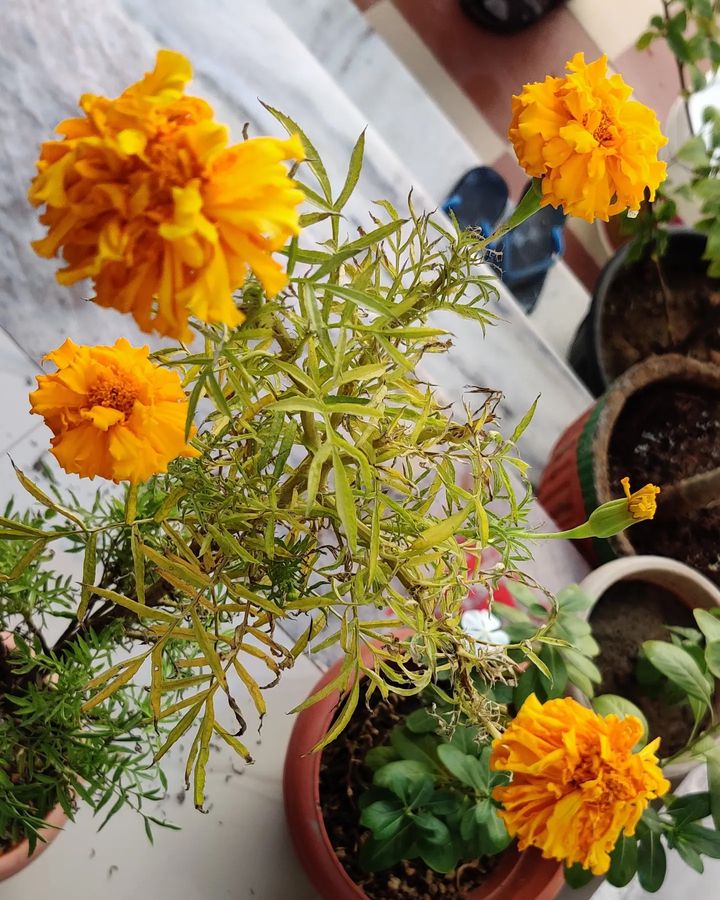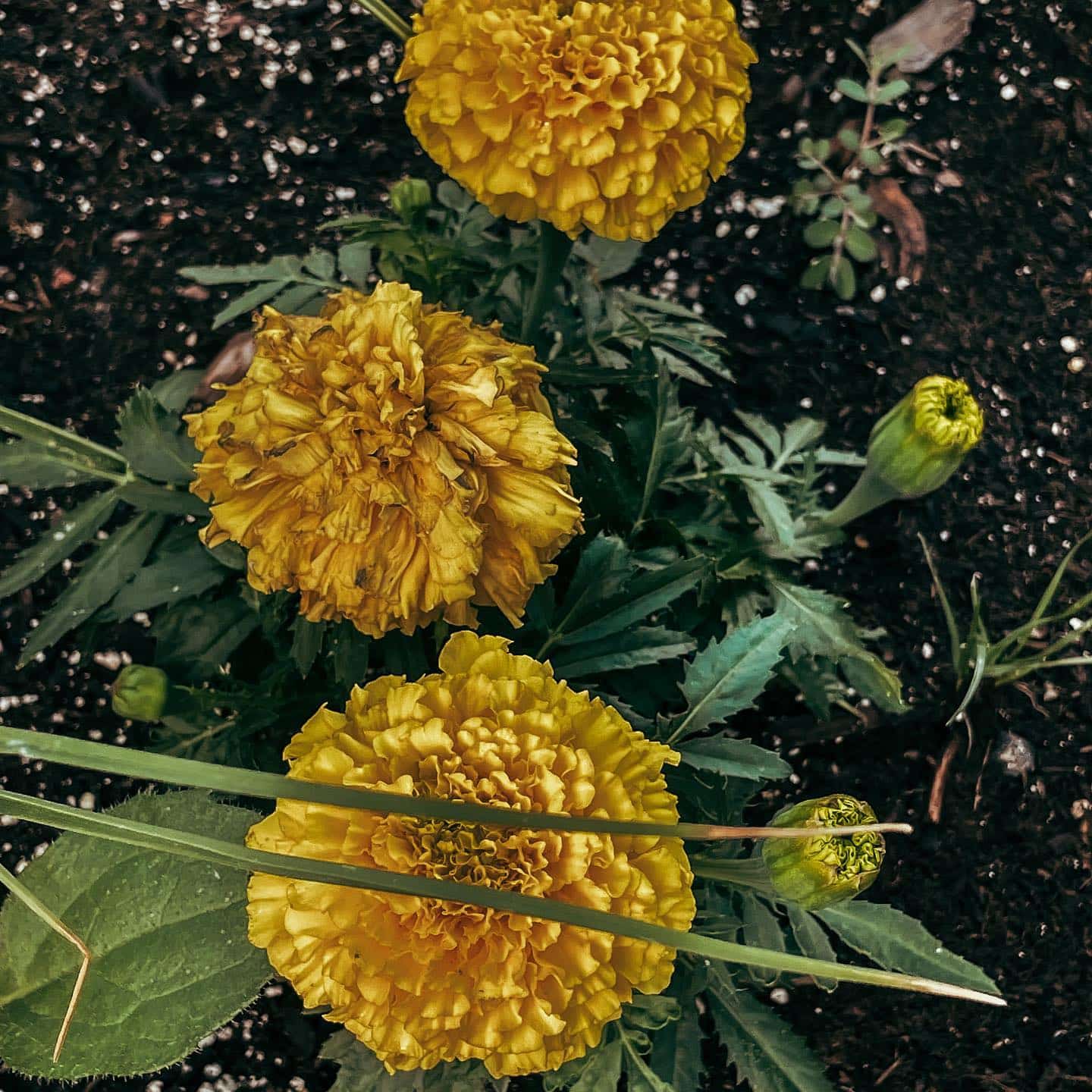It’s normal for your Marigold to droop for some time after repotting due to transplant shock. But if there are other causes, you must hurry to your plant.
Most Marigolds grow as annuals and show die in the winter. But you must be aware of the perennial varieties that witness dying symptoms due to unhealthy care requirements.
Table of Contents Show
Reasons Behind Marigold Plant Dying
The sick Marigold has frail and upright shoots in yellow coloration growing around the base. Besides, Marigold flowers also get deformed, turning into a leaf-like look.

And finally, the plant wilts and dies, so consider the following causes to fix the problems.
1. Improper Watering
The most common reason behind a dying Marigold is improper watering, as the watering demands are based on seasons.
These beautiful plants need maximum water from spring to summer when the blooms arise and least during winter.
As Marigold is native to Mexico and Guatemala with very low rainfall, they don’t like to be in soggy or waterlogged soil.
Besides, Marigolds won’t survive long in tap water with bad water quality having harmful elements like chlorine, fluorine, etc.
2. Sunlight Issues
Although Marigolds are sun-loving plants, excessive or too low sunlight may be the major reason behind your dying Marigold.
Too low sunlight will cause pale leaves, slow growth, and very few blossoms, as the plant can’t photosynthesize properly.
Moreover, excessive sunlight damage the photosynthetic cells causing foliage to burn, wilting, dehydration, browning, etc.
3. Incorrect Temperature
As a tropical plant, Marigold prefers hot temperatures and can’t withstand severe temperature drops or excessive rises.
Too hot a temperature will damage the plant’s foliage and dries the soil quickly that causes dehydration.
Additionally, at a temperature less than 50°F, the plant cannot function properly and starts dying below 32°F.
4. Inadequate Nutrients
Marigolds have high nutrient demands and thrive only in nutrient-rich soil with a balanced NPK value.
When there are inadequate nutrients in the soil, the plant stops functioning to save energy showing the sign of nutrient deficiency.
Eventually, it starts to show the symptoms like drooping, wilting, and yellow leaves, and finally dies due to a shortage of essential nutrients.
Also, your nutrient-deficient Marigold won’t be able to defend against diseases and pests due to the least reserved energy.
5. Fertilizer Problems
If you plan to overfertilize your Marigold for quick growth, you must stop doing this to avoid the worst condition.
Excessive fertilizer causes foliage burn and damages the root system of the plant, causing wilting, browning, and death in severe cases.

Additionally, if the plant is dormant and you force it for fast growth by applying high fertilizer, it can’t handle it and eventually dies.
6. Pests and Diseases
Sometimes, your Marigold may show dying symptoms even if you fail to remove pests and diseases.
Marigold is susceptible to several fungal and bacterial pathogens causing diseases like molds, chlorosis, powdery mildew, leaf spots, etc.
These diseases are further spread by nasty insects like aphids, battles, mealybugs, etc. into different parts.
As the diseases spread in different parts, the plant’s functioning may slow down with symptoms like wilting, drooping, and leaves falling off.
7. Poor Soil and Drainage
Poor soil quality is the root cause of several problems, including nutrient deficiency, diseases, poor air circulation, and many more.
When you grow your Marigold in bad-quality soil with huge compaction and no air circulation, dying symptoms are obvious.
Moreover, your Marigold may face difficulty absorbing water and mineral or soaking rapidly in improper soil.
Not only this, a pot with poor drainage stops air circulation, making the soil waterlogged and inviting many fungal pathogens.
How to Save a Dying Marigold Plant
If the perennial Marigolds show wilting and bare flowers or leaves in the winter, they have undergone dormancy.
But if they invite problems or dying symptoms during the growing season, go through the following methods.
1. Improper Watering
- Hydrate Your dying Marigold before digging it out if the soil is extremely compact; otherwise, tug the plant from the pot.
- Flush the roots with distilled or filtered water and trim the brown or damaged roots.
- Prune the severely affected leaves to avoid pathogenic spread.
- Get a terracotta pot with enough drainage holes and fill it with well-draining soil mixed with organic compost.
- Repot the Marigold 3-4 inches deep in the soil and keep the soil moist.
- Water only after the top 2 inches of the soil feels dry.
- Use the bottom watering method if the soil is extremely dry.
2. Provide Proper Sunlight
- Move your Marigold to an area with adequate sunlight if it’s in a low-light place or vice versa.
- Provide artificial light for at least 12 hours if you place them in a low-light area.
- Place your Marigold on the south-facing window to provide direct sunlight.
- To avoid direct sunlight, use sheer curtains for dappling light.
- Keep your Marigold 3-6 inches far from the window pane.
3. Maintain Appropriate Temperature
- Check the temperature and move your Marigold to a cool, shady place if the temperature is too hot.
- Otherwise, use incandescent light, which will provide warmth to your plant.
- During too-hot weather, water the plant regularly and mist the plant daily.
- Mulching around the plant’s base will work in hot and cold weather.
4. Feed Proper Fertilizer
- Look at the soil’s surface, and if the topsoil has white patches, there is excessive fertilizer.
- Otherwise, you must apply a balanced fertilizer or organic compost only on the soil, leaving the foliage.
- Tug out the overfertilized plant and flush the roots with distilled or filtered water, avoiding tap water.
- Repot your Marigold on the appropriate soil and hydrate before fertilizing the plant.
5. Plant In Well Draining Soil
- Inspect the soil if it smells foul due to fungal contamination. If so, replace the soil with a well-draining potting mix.
- Mix some perlite or sand to improve the drainage of the soil.
- Amend the soil with organic compost for the best results.
- Avoid pressing the soil hard to prevent compactness of the soil.
6. Pests and Diseases
- Isolate your Marigold to prevent the spread of disease to other plants.
- Inspect and prune the infected parts immediately to avoid spreading to other parts.
- Look closely at the bottom of the leaves for insect eggs and remove them with a brush or hands.
- Clean the plant regularly to avoid any infections to the plant’s parts.
- To control the infection, use suitable pesticides or fungicides once a week.
- If you want a safer option, use Neem oil weekly to avoid any pests and pathogens.
How to Grow & Care for Marigold
- Choose the right location with at least 6 hours of direct sunlight before planting Marigold.
- It’s best to grow Marigolds in pots rather than on the ground, as you can change the location.
- Water and fertilize your Marigold only during growing seasons.
- Your Marigolds will need water every 2-3 days during the growing season and every week during winter or dormancy.
- Remember that your marigold prefers a temperature of 68°F to 75°F for healthy growth and good blooms.
- Feed your Marigold with balanced fertilizer with NPK value 10-10-10 during the growing season once a month.
- Use frost blankets and keep your Marigold far from cold drafts, heating vents, etc.
- Deadhead the spent flowers to save energy and encourage blooming.
- Inspect your Marigold timely for any diseases and treat them immediately.
From Editorial Team
Grow Marigolds with the Best Companion Plants!
Alyssum, Cilantro, Rosemary, Kale, Cosmos, tomatoes, Garlic, etc., are the best companion plants for Marigolds.
These plants reduce excessive water loss and prevent your Marigolds from harmful pests by attracting beneficial insects.


